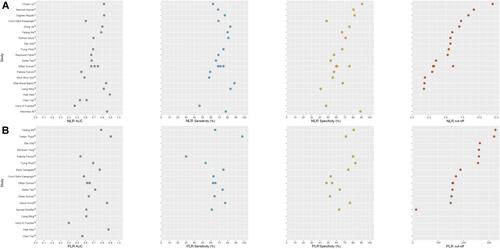Figures & data
Figure 1 (A) The number of studies on immune/inflammation biomarkers in VTE increased dramatically from 2005 to 2021. (B) A number of researchers around the world have published numerous research findings in this area, among which American researchers have published papers with the highest impact factors. (C) Studies on immune/inflammation biomarkers are conducted in various countries, among which Turkish researchers have reported the most.

Table 1 Studies of NLR for VTE
Figure 2 (A) The AUC of NLR ranged from 0.47 to 0.893, the sensitivity from 46.2% to 88.2%, the specificity from 41% to 90.9%, and the cutoff value from 1.76 to 12, indicating that NLR provide promising predictive capability for VTE, but the results varied between studies. (B) The AUC of PLR ranged from 0.4 to 0.905, the sensitivity from 30% to 97.66%, the specificity from 47.9% to 82.8%, and the cutoff value from 12.8 to 325, indicating that PLR has certain predictive value for VTE, whereas the results also varied between studies.

Table 2 Studies of PLR for VTE
